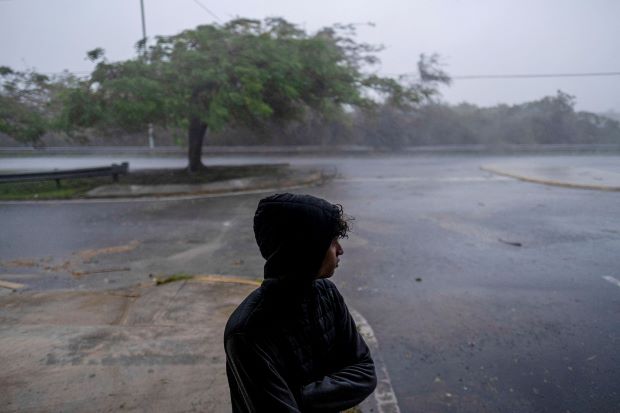Hurricane Fiona knocks out power in Puerto Rico as heavy rains continue
SAN JUAN – Five years after Hurricane Maria battered Puerto Rico and knocked out power to the island, residents of the territory faced another collapse of their energy grid as Hurricane Fiona — which forecasters warned could bring up to 2 1/2 feet of rain and cause life-threatening floods and landslides — made landfall.
Nearly 1.5 million customers were without electricity Sunday (18) afternoon, according to poweroutage.us, which tracks power interruptions.
Pedro Pierluisi, the governor of Puerto Rico, said at a news conference Sunday afternoon that authorities were assessing damage and working to stave off a growing disaster. He said officials were rescuing people in isolated areas and deploying the National Guard and other personnel to evacuate low-lying areas where rivers were expected to flood.
“Hurricane Fiona has blanketed Puerto Rico,” Pierluisi said in Spanish, adding that the storm has been one of the most significant to hit since Hurricane Maria devastated it in 2017. “This has been a direct impact that has covered all of the island.”
The storm was moving toward the Dominican Republic, where it was expected early Monday (19) morning according to the latest forecasts. The Dominican president, Luis Abinader, said during a Sunday night news conference that the electricity company and government agencies had personnel “at the ready” to respond to emergencies.
Heavy rains were still expected overnight in Puerto Rico. Since Hurricane Maria, unreliable electricity has been a mainstay of life on the island, leading to a slow recovery and widespread protests by frustrated residents.
When asked what went wrong with the island’s power grid, Jaclyn Rothenberg, a spokesperson for the Federal Emergency Management Agency, said Sunday that the agency’s priority was how to meet immediate needs, and a diagnosis of what had gone wrong would have to come later.
“Our focus remains on critical needs and lifesaving efforts, should there be any, given the fact that the storm is literally hovering over the island,” Rothenberg said.
Power company LUMA warned Sunday that full power restoration could take several days. It said that the storm was “incredibly challenging” and that restoration efforts would begin when it was safe to do so.
“The current weather conditions are extremely dangerous and are hampering our ability to fully assess the situation,” it said on its website.
When Hurricane Maria struck Puerto Rico as a Category 4 storm, it produced as much as 40 inches of rainfall and caused the deaths of an estimated 2,975 people. On Sunday morning, Fiona strengthened from a tropical storm to a Category 1 hurricane.
Deanne Criswell, the FEMA administrator, said in a statement late Sunday that the agency deployed hundreds of personnel to Puerto Rico before the storm made landfall and the primary focus was on saving lives and immediate needs like power restoration. She urged Puerto Ricans to check on their neighbours and loved ones.
“We also understand that people are reliving the experience of Hurricane Maria, almost five years to the date, and we will do everything to ensure that all Puerto Ricans have what they need to recover from Hurricane Fiona,” Criswell said.
Fiona made landfall, meaning the eye of the storm crossed the shoreline, along the southwestern coast of Puerto Rico near Punta Tocon around 3:20 p.m. local time, the National Hurricane Center said.
Significant flooding had already occurred, and it was likely the rain would continue through Monday morning, said Jamie Rhome, acting director of the National Hurricane Centre.
Forecasters said the centre of Fiona was expected to move over eastern parts of the Dominican Republic on Monday. The northern and eastern parts of the country could get 4 to 8 inches of rain, with isolated areas of up to 1 foot. A hurricane warning was in effect for the coast of country, from Cabo Caucedo to Cabo Frances Viejo.
While still a tropical storm, Fiona brought flooding to Guadeloupe, an island southeast of Puerto Rico, and there was at least one storm-related death in the capital, a government official said Saturday.
In Puerto Rico, rainfall totals could reach 12 to 16 inches, with local maximum totals of 30 inches, particularly across eastern and southern Puerto Rico, forecasters said. The rain threatened to cause not only flash flooding across Puerto Rico and portions of the eastern Dominican Republic but also mudslides and landslides.
At a Sunday morning news conference, Pierluisi urged people to stay in their homes if they could or evacuate if they lived in an area prone to landslides or floods.
Public schools on the island will be closed Monday, he said, and only public employees who perform essential roles or respond to emergencies should report to work.
On Sunday, President Joe Biden approved an emergency declaration for Puerto Rico, authorizing federal agencies to coordinate disaster relief efforts.
The storm surge and tide from heavy rains in Puerto Rico could flood normally dry areas along the coast, and forecasters warned that the water could reach 1 to 3 feet on the southern coast if the peak surge occurred at high tide.
The storm could bring 4 to 6 inches of rain to the British and US Virgin Islands and up to 10 inches on St. Croix, forecasters said.
If the storm continues on a north-northwest track, it could affect the Bahamas, the Hurricane Center said.
-New York Times



Comments are closed, but trackbacks and pingbacks are open.